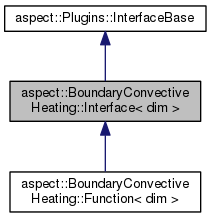 |
ASPECT
|
 |
ASPECT
|

Public Member Functions | |
| virtual std::vector< double > | heat_transfer_coefficient (const types::boundary_id boundary_indicator, const MaterialModel::MaterialModelInputs< dim > &material_model_inputs, const MaterialModel::MaterialModelOutputs< dim > &material_model_outputs) const =0 |
 Public Member Functions inherited from aspect::Plugins::InterfaceBase Public Member Functions inherited from aspect::Plugins::InterfaceBase | |
| virtual | ~InterfaceBase ()=default |
| virtual void | initialize () |
| virtual void | update () |
| virtual void | parse_parameters (ParameterHandler &prm) |
| virtual void | save (std::map< std::string, std::string > &status_strings) const |
| virtual void | load (const std::map< std::string, std::string > &status_strings) |
Additional Inherited Members | |
 Static Public Member Functions inherited from aspect::Plugins::InterfaceBase Static Public Member Functions inherited from aspect::Plugins::InterfaceBase | |
| static void | declare_parameters (ParameterHandler &prm) |
Base class
Definition at line 86 of file simulator_access.h.
|
pure virtual |
Compute the heat transfer coefficients for a list of evaluation points.
The heat transfer coefficient characterises convective heat exchange between the solid model interior and an adjacent fluid. It is defined as
heat flux = heat transfer coefficient (T_wall − T_infinity),
where T_wall is the local surface temperature of the solid computed by the solver and T_infinity is the temperature of the fluid outside of the model. In the context of a Robin boundary condition, the heat transfer coefficient governs the strength of the convective coupling: For heat transfer coefficient –> zero, the boundary approaches insulating (Neumann) behavior; For heat transfer coefficient –> infinity, the boundary approaches a prescribed-temperature (Dirichlet) condition with T = T_infinity.
The unit of the heat transfer coefficient is W/m^2/K.
| boundary_indicator | The boundary indicator of the part of the boundary of the domain on which the evaluation points are located and where we are requesting the heat transfer coefficients. |
| material_model_inputs | The material property inputs. |
| material_model_outputs | The material property outputs. |
Implemented in aspect::BoundaryConvectiveHeating::Function< dim >.